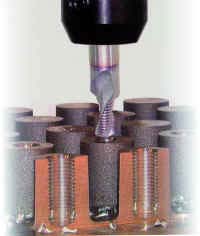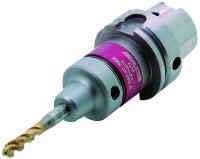Tapping into new Technology
Post Date: 03 Sep 2009 Viewed: 797
The maturing of CNC machine tools, growth in CNC synchronous tapping, high pressure coolant through spindles and modern tap holders, when combined with application-specific tap geometries and coatings have all contributed to advances in the production of internal screw threads. Thread milling technology is also contributing to a rethinking of the production of an internal screw thread.
Making an internal screw thread faster, with better quality and reduced cost is always a challenge, easily met with today's technologies. Not long ago Emuge suggested running taps in cast iron at 35 to 50 sfm. Today tapping speeds of 100 to 250 sfm are easily achieved. In mild steel we formerly suggested 25 to 80 sfm. Today speeds easily reach 100 to 300 sfm. For good measure solid carbide thread mills can produce the same thread at 260 to 820 sfm.

Better machines, better results
CNC machines of today are faster, more accurate and simpler to operate and program than those of just a few years ago. The ability to accelerate, stop and accelerate in reverse quickly, is vital to tapping threads efficiently. Machine tool technology has developed more stable machines, providing the best environment for producing internal threads. High-pressure coolant through the spindle is important to maximize threading speed, thread quality and tool life.
Developing taps to be faster, better and last longer takes a continued engineering effort that does not stop at the factory laboratories. Emuge engineers continually visit customers and work first hand with their toolholding and threading applications. In both tapping and thread milling, understanding and using correct CNC programming is essential. The data contained in the accompanying table shows a typical time comparison between full-speed tapping and thread milling.

Looking at the accompanying time comparison, the thread milling cutter with countersink in this case produced the fastest time...even though the Thriller had lower tool cycle times. This is due to the fact that the thread mill had four flutes while the Thriller only has two flutes. Had this been a smaller size such as M6, the full speed tap and Thriller would have been better choices.
This is a faster way of threading than to tap at a conventional speed of 65 sfm. Understanding the benefit of full-speed threading is the beginning to improving productivity and generating real cost savings.
To be fair, not every company has the luxury of the latest CNC machining center to take advantage of the latest tooling developments. However, this should not prevent them from producing threads faster, with better quality and at less cost per hole. These companies should examine the threading process in the same manner we do for developing new taps for modern CNC applications and consider the following steps to tap selection:
Consider the material and material hardness being tapped and select a tap specifically designed for that application. All manufacturers of taps now offer a wide variety of taps for most all material being tapped.
Consider the hole configuration. If the hole is blind or part way into a through hole, then choose a spiral-fluted tap that will extract the chips out of the top of the hole. If the threads are completely through the hole then choose a spiral pointed tap that will efficiently push the chips through the bottom of the hole.
Always choose a surface coating such as TiN, TiCN, CrN, TiAlN and so on, for the tap for threading. The surface coatings extend tap life, reduce cutting pressure, aid in chip removal and allow for faster cutting speeds.
Consider investing in new tap holders. Tap holders built today are of much better quality than those of just a few years back. If you do not want to invest in new holders then at the very least do preventative maintenance on the holders, lubricate them and make sure the tension/compression features work smoothly. Many older holders become bound up from coolant residue and many just wear out.

In all threading applications, performance can be improved by adding coolant through the tap. This feature, especially with high pressure (700 psi), adds a new dimension making internal screw threads. Taps can now be run much faster without the fear of generating too much heat. Tapping in the horizontal plain is even more important as coolant from external flows has a hard time reaching the cutting area of a tap in the bottom of a hole.



